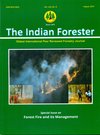Forest Fire Zone Demarcation in Uttara Kannada District Using GIS Techniques
DOI:
https://doi.org/10.36808/if/2017/v143i8/118980Keywords:
Forest, Fire Intensity, GIS, Spatial Location.Abstract
The study was taken up to assess the intensity of forest fire in different talukas of Uttara Kannada district. The fire spots in Uttara Kannada district from 2012-2016 was taken from the State Forest Report 2016, Forest Survey of India. The location of the fire spots (Latitude and Longitude) are converted in to shape file. The fire spots are shown in the map from 2012 to 2016. The forest fire intensity over the period of five years are exhibited in separate map and fire intensity from very low to high has been depicted. The results indicated that the higher fire intensity zone is found in north and north east part of the Uttara Kannada district covering the taluka of Mundgod, Haliyal and part of Jioda. Moderate fire intensity zone is covered in part of Mundgod, Yellapur and Joida. Remaining talukas are having low to very low forest fire intensity. The higher forest fire zone in Mundgod, Haliyal and part of Jioda taluka is due to the dry deciduous forest.References
Botton S. and Duquenne F. (1997). GPS, location and navigation. Edition Hermes: Paris, France.
Chengcheng Gai, Wenguo Weng, and Hongyong Yuan (2011). GIS-based forest fire risk assessment and mapping. Conference Paper
George L.W., Ashley Perry Sparrow D., Ian F. and Owens (1999). A GISsupported model for the simulation of the spatial structure of wildland fire, Cass Basin, New Zealand. J. Applied Ecology, 36(4): 502–518.
Goodrick S. and Jim B. (1999). Florida's fire management information system. In: Proceedings from the Joint Fire Science Conference and Workshop, Moscow, Idaho: University of Idaho. 1, 3-11.
Ilmavirta A. (1995). The use of GIS-system in catastrophe and emergency management in Finnish municipalities. Computers, Environment and Urban Systems, 19:171–178.
Keramitsoglou I., Kiranoudis C.T. and Sarimveis H., (2004). A multidisciplinary decision support system for forest fire crisis management. Environmental Management, 33(2): 212–225.
Lenihan J.M., Daly C., Bachelet D. and Neilson R.P. (1998). Simulating broad scale fire severity in a dynamic global vegetation model. Northwest Science, 72(4): 91–101.
Lymberopoulos N., Papadopoulos C. and Stefanakis L. (1996). A GIS-based forest fire management information system. EARSeL Advances in Remote Sensing, 4(4): 68–75.
Jaiswal R.K., Mukherjee S. and Raju K.D. (2002). Forest fire risk zone mapping from satellite imagery and GIS, International Journal of Applied Earth Observation and Geo-information, 4:1-10.
Karnataka State Natural Disaster Monitoring Centre, 2017
Morgan P., Hardy C.C., Thomas W.S., Matthew G., Rollinsand Donald G. Long. (2001). Mapping fire regimes across time and space: Understanding coarse and fine-scale fire patterns. Inter. J. Wild and Fire, 10: 329–342.
Saklani P. (2008). Forest fire risk zonation: a case study in Pauri Garhwal, Uttrakhand, Inida.1-71.
Puyravaud J.P. Pascal J.P. and Dufour C. (1994). Ecotone structure as an indicator of changing forest-savanna boundaries (Linganamakki Region, southern India), Journal of Biogeography, 21(6): 581–593.
Sauvagnargues S., Dusserre G. and Poppi J.C. (1997). Geographical information systems applied to security services. Inter. J. GIS and Spatial Analysis,7: 353–371.Botton S. and Duquenne F. (1997). GPS, location and navigation. Edition Hermes: Paris, France.
Downloads
Downloads
Published
How to Cite
Issue
Section
License
Unless otherwise stated, copyright or similar rights in all materials presented on the site, including graphical images, are owned by Indian Forester.





